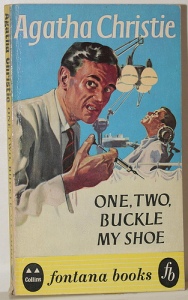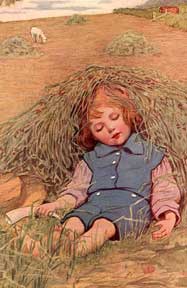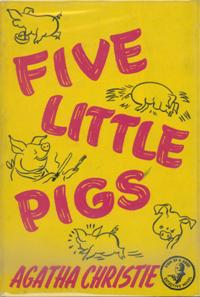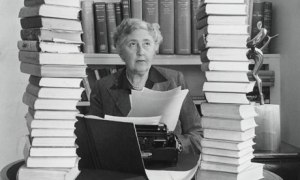 Si riporta, qui di seguito, un elenco dettagliato dei romanzi di Agatha Christie in cui l’autrice ricorre all’utilizzo di almeno una nursery rhyme:
Si riporta, qui di seguito, un elenco dettagliato dei romanzi di Agatha Christie in cui l’autrice ricorre all’utilizzo di almeno una nursery rhyme:
1) Dieci piccoli indiani (1939): And Then There Were None anche nota come Ten Little Niggers. È la filastrocca che determina la lunga serie di omicidi perpetrati dall’assassino: Ten little Indian Boys went out to dine;/One choked his little self and then there were nine./Nine little Indian Boys sat up very late;/One overslept himself and then there were eight./Eight little Indian Boys travelling in Devon;/One said he’d stay there and then there were seven./Seven little Indian Boys chopping up sticks;/One chopped himself in halves and then there were six./Six little Indian Boys playing with a hive;/A bumblebee stung one and then there were five./Five little Indian Boys going in for law;/One got in Chancery and then there were four./Four little Indian Boys going out to sea;/A red herring swallowed one and then there were three./Three little Indian Boys walking in the zoo;/A big bear hugged one and then there were two./Two little Indian Boys sitting in the sun;/One got frizzled up and then there was one./One little Indian Boy left all alone; He went out and hanged himself and then there were none.
2) Poirot non sbaglia (1940): One, Two, Buckle My Shoe. È la filastrocca da cui è tratto il titolo originale del romanzo e le cui strofe scandiscono i vari capitoli, viene abitualmente utilizzata per insegnare ai bambini a contare: One, two, buckle my shoe/Three, four, close the door/Five, six, pick up sticks/Seven, eight, lay them straight/Nine, ten, a good fat hen/Eleven, twelve, men must delve/Thirteen, fourteen, maids a-courting/Fifteen, sixteen, maids in the kitchen/Seventeen, eighteen, maids are waiting/Nineteen, twenty, my plate empty. Nella traduzione di Alberto Tedeschi è resa nel modo seguente: Uno, Due, mettimi una fibbia sulla scarpa/Tre, Quattro, chiudi la porta/Cinque, Sei, raccogliere stecchetti/Sette, Otto, disporli nell’ordine giusto/Nove, Dieci, una bella pollastra/Undici, Dodici, gli uomini devono scavare/Tredici, Quattordici, le fanciulle sono innamorate/Quindici, Sedici, le ragazze in cucina/Diciassette, Diciotto, zitelle in attesa/Diciannove, Venti, ho il piatto vuoto.
3) Il ritratto di Elsa Greer (1942): This Little Piggy. Hercule Poirot fa un collegamento mentale tra il caso che sta affrontando e questa filastrocca infantile che viene utilizzata come conta sulle dita: This little piggy went to market,/This little piggy stayed home,/This little piggy had roast beef,/This little piggy had none,/And this little piggy went wee wee wee all the way home. Nella traduzione di Beata della Frattina, viene resa nel modo seguente: Questo porcellino andava al mercato/Questo porcellino se ne stava a casa/Questo porcellino mangiava l’arrosto/Questo porcellino non aveva niente/Questo porcellino gridava ahi… ahi… ahi.
 4) Alla deriva (1948): Little Boy Blue. Nel romanzo, Mrs. Cloade afferma che questa celebre nursery rhyme le è stata comunicata dagli spiriti come messaggio: Little Boy Blue,/Come blow your horn,/The sheep’s in the meadow,/The cow’s in the corn;/Where is that boy/Who looks after the sheep?/Under the haystack/Fast asleep./Will you wake him?/Oh no, not I,/For if I do/He will surely cry. Si pensa, ma non è assodato, che questa filastrocca sia nata come propaganda contro il cardinale Thomas Wolsey (1475-1530).
4) Alla deriva (1948): Little Boy Blue. Nel romanzo, Mrs. Cloade afferma che questa celebre nursery rhyme le è stata comunicata dagli spiriti come messaggio: Little Boy Blue,/Come blow your horn,/The sheep’s in the meadow,/The cow’s in the corn;/Where is that boy/Who looks after the sheep?/Under the haystack/Fast asleep./Will you wake him?/Oh no, not I,/For if I do/He will surely cry. Si pensa, ma non è assodato, che questa filastrocca sia nata come propaganda contro il cardinale Thomas Wolsey (1475-1530).
5) È un problema (1949): There Was a Crooked Man. Datata 1842 e riferita ai rapporti burrascosi tra inglesi e scozzesi. Da essa deriva il titolo originale del romanzo, Crooked House: There was a crooked man and he walked a crooked mile,/He found a crooked sixpence upon a crooked stile/He bought a crooked cat , which caught a crooked mouse/And they all lived together in a little crooked house.
6) Tre topolini ciechi e altre storie (1950): Three Blind Mice. Nel racconto dal medesimo titolo compare la filastrocca omonima, datata 1805 e riferita a Mary la sanguinaria che fece bruciare sul rogo tre suoi oppositori: Three blind mice, Three blind mice/See how they run, see how they run/They all ran after the farmer’s wife/Who cut off their tails with a carving knife/Did you ever see such a sight in your life/As three blind mice?
7) Polvere negli occhi (1953): Sing a Song of Sixpence. Il titolo originale del romanzo è tratto da uno dei versi della filastrocca, pubblicata per la prima volta nel 1744: Sing a song of sixpence, A pocket full of rye, Four and twenty blackbirds Baked in a pie./When the pie was opened The birds began to sing— Wasn’t that a dainty dish To set before the king?/The king was in the counting-house Counting out his money, The queen was in the parlor Eating bread and honey,/The maid was in the garden Hanging out the clothes. Along came a blackbird And snipped off her nose. Nella traduzione di Grazia Maria Griffini è stata resa come segue: Canta una canzone da sei soldi, una tasca piena di segale. Ventiquattro merli chiusi dentro una focaccia./Quando la focaccia è stata tagliata i merli si sono messi a cantare. Non era degno di un re un piatto così pregiato?/Il re stava nella stanza del tesoro a contare le sue monete, La regina era in salotto a mangiare pane e miele./La servetta era in giardino a stendere il bucato, quando è arrivato un uccellino a beccarle via il nasino.
Curiosità: La medesima filastrocca compare anche nel racconto Canta una canzone da sei soldi pubblicato nella raccolta Il mistero di Listerdale (o di Lord Listerdale) e altre storie (1934) e anche nel racconto La torta di more pubblicato nella raccolta Il caso del dolce di Natale e altre storie (1960).
8) Poirot si annoia (1955): Hickory Dickory Dock. È la filastrocca da cui è tratto il titolo originale del romanzo, è datata 1744 e viene abitualmente insegnata ai bambini in età prescolare affinché imparino lo scorrere del tempo: Hickory Dickory Dock/The mouse ran up the clock/The clock struck one/The mouse ran down/Hickory Dickory Dock. Nel testo originale la filastrocca è riportata in esergo, nella traduzione italiana viene omessa.
9) Sfida a Poirot (1963): For Want of a Nail. Hercule Poirot cita questa filastrocca, datata 1390 e poi ripresa anche da Benjamin Franklin nel suo saggio The Way to Wealth (1758), in riferimento al fatto che solo una persona poteva avere giustificati motivi per commettere un certo omicidio: For want of a nail the shoe was lost/For want of a shoe the horse was lost/ For want of a horse the rider was lost/For want of a rider the battle was lost/For want of a battle the Kingdom was lost/ And all for the want of a horseshoe nail. Nella traduzione di Moma Carones viene resa come segue: Al ferro di cavallo mancava un chiodo,/e per la mancanza di quel ferro si perdette il cavallo,/mancando il cavallo la battaglia fu perduta,/e per quella sconfitta si perdette anche il Regno./E tutto perché mancava un chiodo al ferro di cavallo.
 10) Sono un’assassina? (1966): Rub-a-dub-dub. Nursery rhyme, risalente al 1798, che balena nella mente di Poirot mentre cerca di capire il comportamento della ragazza protagonista del libro: Rub-a-dub-dub, Three men in a tub, And who do you think they were? The butcher, the baker, The candlestick-maker, They all sailed out to sea, ‘Twas enough to make a man stare. Nella traduzione di Grazia Maria Griffini è riportata nel modo seguente: Rub a dub dub, tre uomini in una tinozza/e chi credete che siano?/Un macellaio, un fornaio e un candelaio…
10) Sono un’assassina? (1966): Rub-a-dub-dub. Nursery rhyme, risalente al 1798, che balena nella mente di Poirot mentre cerca di capire il comportamento della ragazza protagonista del libro: Rub-a-dub-dub, Three men in a tub, And who do you think they were? The butcher, the baker, The candlestick-maker, They all sailed out to sea, ‘Twas enough to make a man stare. Nella traduzione di Grazia Maria Griffini è riportata nel modo seguente: Rub a dub dub, tre uomini in una tinozza/e chi credete che siano?/Un macellaio, un fornaio e un candelaio…
11) Sono un’assassina? (1966): Pat-a-cake, pat-a-cake, baker’s man. Filastrocca del 1698 di cui Poirot realizza una parodia, unendola alla precedente Rub-a-dub-dub, in riferimento all’indagine di cui si sta occupando (Pat a cake, pat, three girls in a flat / And who do you think they be? / A Personal Aide and a girl from the Slade And the Third is a…): Pat-a-cake, Pat-a-cake, baker’s man/Bake me a cake as fast as you can/Pat it and prick it and mark it with “B”/ And put it in the oven for Baby and Me. Nella traduzione di Grazia Maria Griffini la parodia è riportata nel modo seguente: Impasta la torta, impasta, tre ragazze nella stessa casa/e chi credete che siano?/una segretaria privata e una ragazza che viene da Slade/e la terza è una…
12) I primi casi di Poirot (1974): Nel racconto Come va il vostro giardino?, già pubblicato in precedenza nel volume In tre contro il delitto (1939), compare la filastrocca Mary, Mary, Quite Contrary. Il titolo del racconto, infatti, è tratto da uno dei versi di questa nursery rhyme: Mary, Mary quite contrary/How does your garden grow?/With silver bells and cockle shells/And pretty maids all in a row. La filastrocca si riferiva, verosimilmente, a Mary la sanguinaria e al suo modo di perseguire gli oppositori religiosi.
13) I primi casi di Poirot (1974): Nel racconto Il mistero di Market Basing compare la filastrocca The rabbit has a charming face: The rabbit has a charming face: Its private life is a disgrace/I really dare not name to you/The awful things that rabbits do;/Things that your paper never prints/You only mention them in hints/They have such lost, degraded souls/No wonder they inhabit holes;/When such depravity is found/It only can live underground.


Pingback: Paura in rima
Pingback: Riferimenti ad Agatha Christie nella serie tv La signora in giallo | Il rifugio di Agatha Christie